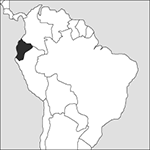
Source: MAPS IN MINUTES™ © RH Publications (1997)
Capital:
Quito
Area:
283,561 sq km (103,484 sq miles)
Population:
15,439,429 (2012 est)
Currency:
1 US dollar = 100 cents
Religions:
Roman Catholic 95.0%
Ethnic Groups:
Mestizo 71.9%; Montubio 7.4%; Afroecuadorian 7.2%; Amerindian 7.0%; White 6.1%
Languages:
Spanish (official); Quechua; Shuar
International Organizations:
UN; OAS; Andean Community; Non-Aligned Movement; WTO; OPEC
A country on the north-west coast of South America.
Physical
Ecuador is bounded by Colombia on the north-east and Peru on the east and south. The Andes run north to south through the middle of the country and between the peaks are high but fertile valleys where the climate is temperate.
Economy
The oil industry, nationalized since 1988, produces over half the country’s export earnings, but otherwise the economy is primarily agricultural with exports including bananas (of which Ecuador is the world’s leading exporter), coffee, and cut flowers. Oil revenues have been invested to develop some manufacturing industry. There are plentiful supplies of natural gas and hydroelectric power to meet domestic energy requirements, and also mineral deposits of lignite, gold, and silver.
History
By c.500 ad independent kingdoms had developed with two cultural regions—a coastal one, adapted to the open sea, and one adapted to the interior environment. The Incas conquered the central valley in the 15th century, and their communications network included a road from Cuzco to Quito, which they set up as their regional capital. The Spaniard Pizarro united the region to his Peruvian conquests in 1535 and installed his brother, Gonzalo, as governor. Internal dissensions led to a take-over by the Spanish crown and the establishment of Quito as an Audiencia (a high court with a political role) under the viceroy of Peru.
With the victory at Pichincha (1822) by Antonio Sucre Ecuador gained independence, joining Gran Colombia. When this broke up (1830) it became a separate republic, whose politics reflected the tension between the conservative landowners of the interior and the more liberal, business community of the coastal plain. This led to an almost total breakdown in government (1845–60). Garcia Moreno ruthlessly re-established order as President (1860–75) and, on his assassination, there was a period of stable government under anti-clerical liberal governments. After World War I increasing poverty of the masses led to political turbulence. Although US military bases in World War II brought some economic gain, a disastrous war with Peru (1941) forced Ecuador to abandon claims on the Upper Amazon. Between 1944 and 1972 the caudillo José Maria Velasco Ibarra alternated with the military as ruler, being elected President five times. The discovery of oil in the 1970s might have brought new prosperity, but in fact the mass of the population remained poor and illiterate, with the great haciendas surviving intact. Democratic government was restored in 1979 with the election of the social democrat Jaimé Roldos Aquilera as President (1979–81). He had promised reform but died in a mysterious air-crash. His successor, Osvaldo Hurtado Larrea (1981–84), was accused of embezzlement, and President Febres Cordero (1984–88) faced military intervention, a major crisis of external indebtedness, trade union unrest, and a decline in the oil price. The Democratic Left Party under Rodrigo Borja Cevallos came to power in 1988. It took over management of the oil companies, but still faced grave economic problems. Following elections in 1992 a coalition government was formed under President Sixto Durán Ballén. He introduced free-market reforms and cut public spending, provoking popular unrest, and was replaced in 1996 by Abdala Bucaram (known as ‘El Loco’, the madman). In 1995 a recurrent border dispute with Peru flared up again, but was settled after several days of fighting. In 1997 Bucaram was ousted on grounds of insanity and Jamil Mahuad was elected President in 1998. An economic crisis in 2000 led to a military coup, which installed Vice President Gustavo Noboa as President. However, in 2002 the coup leader, Lucio Gutiérrez, was elected President. He was dismissed by Congress in 2005 and replaced by Alfredo Palacio. The left-wing Rafael Correa was elected President in 2006. Ecuador defaulted on its public debt in 2008 and a new constitution that strengthened presidential power came into effect that same year. The power of the presidency was again increased in 2011, following police and military unrest in 2010. Correa was re-elected in 2009 and 2013. His radical political programme accelerated after his 2013 election, with plans for greater redistribution of wealth, reform of the courts, and controls on the media. Correa did not stand in the 2017 elections, supporting Lenin Moreno. In a referendum in 2018 the two-term limit on presidents was reintroduced, removing Correa’s hope of a comeback in 2021.
- ruff
- Ruffini’s capsule
- Rugosa
- rugose
- rugosity
- rugplot
- ruin theory
- rule
- rule-based system
- ruled surface
- rule-following considerations
- rule gamma (γ)
- rule necessitation
- rule of inference
- rule of law
- rule of necessitation
- rule of recognition
- rule of succession
- rule of Vs
- rule/principle
- ruler and compass construction
- rules-based policy
- rules of origin
- rules of the game
- rules of thumb